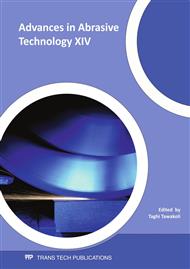[1]
Panhorst, H. -J.: Seilsägen von Granit mit Diamantwerkzeugen – Systematische Entwicklung eines Trennwerkzeuges, Dr. -Ing. Dissertation, Universität Hannover, (1974).
Google Scholar
[2]
Denkena, B., Glatzel, T., Bockhorst, J., Lünemann, M.: Machining of construction materials with wire saws, Industrial Diamond Review, Volume 2-2005, pp.58-64.
Google Scholar
[3]
Tönshoff, H.K., Hillmann-Apmann, H.: Diamond tools for wire sawing metal components, Diamond and Related Materials, Volume 11, Issues 3-6, March-June 2002, pp.742-748.
DOI: 10.1016/s0925-9635(01)00727-0
Google Scholar
[4]
N.N.: U-boat sawn up with diamond wire, Industrial Diamond Review, Volume 2-2008, pp.14-15.
Google Scholar
[5]
Jennings, M.: Diamond wire sawing provides the power, Industrial Diamond Review, Volume 1-2008, pp.14-15.
Google Scholar
[6]
Beckmann, T.R., Bjerier, J.: Diamnd wire cutting of heat exchangers, International Conference on Nuclear Engineering, Icone 1, Log No. 260 – Plant Decomissioning Tokyo, Japan, 1991, pp.84-89.
Google Scholar
[7]
Schmitz, A, Ambos, F., Danner, C., Siegenthaler, E.: Trocken-Seilsägen an Beton- und Stahlstrukturen in kerntechnischen Anlagen, Proceedings zur Internationalen Schneidtechnischen Tagung 2006, Hannover, 10. -11. Oktober (2006).
Google Scholar
[8]
Apmann, H.: Seilschleifen von metallischen und mineralischen Werkstoffen, Dr. -Ing. Dissertation, Universität Hannover, (2004).
Google Scholar
[9]
Fratini, L., Liguori, V., Oriti, B.: On the slabbing of stones through diamondwire cutting operations, Proceedings of the Institution of Mechanical Engineers, Part C: Journal of Mechanical Engineering Science, Volume 224, 1-2010, pp.143-148.
DOI: 10.1243/09544062jmes1752
Google Scholar
[10]
Risso, L., Vicenzi, B., Bernieri, S.: Improved Cutting Performance of Diamond Beads by Means of Innovative Shape, Presentation Diamond at Work, 2nd International Industrial Diamond Conference, Rome, April, 19. -20. (2007).
Google Scholar
[11]
Ozcelik, Y.: Optimum working conditions of diamond wire cutting machines in marble industry, Industrial Diamond Review, Volume 65 (2005), pp.58-64.
Google Scholar
[12]
Hilti Corporation, N.N.: Bedienungsanleitung Diamant-Seilsägesystem, (2001).
Google Scholar
[13]
Tyrolit Hydrostress AG, N.N.: Sicherheitshandbuch – Diamantseilsägen, Volume 08. 09. (2003).
Google Scholar
[14]
Denkena, B., de Leon, L., Seiffert, F.: Process Influences in the Wire Cutting of Concrete, In: Advanced Materials Research, Vols. 126-128 (2010), pp.70-76.
DOI: 10.4028/www.scientific.net/amr.126-128.70
Google Scholar
[15]
Abele, E., Schramm, B.: Using PCD for machining CGI with a CO2 coolant system, In: Production Engineering – Research and Development, 2008-2, pp.165-169.
DOI: 10.1007/s11740-008-0104-6
Google Scholar
[16]
Klocke, F., Linke, B.: Mechanisms in the generation of grinding wheel topography by dressing, In: Production Engineering – Research and Development, 2008-2, pp.157-163.
DOI: 10.1007/s11740-008-0101-9
Google Scholar


